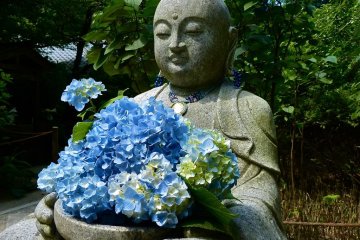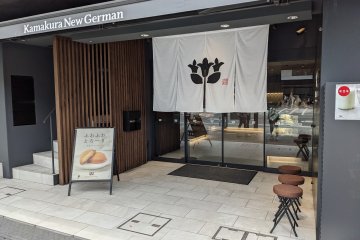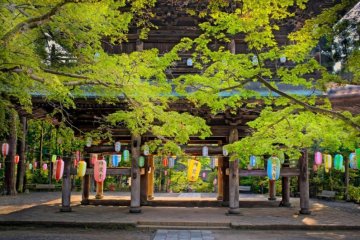
วัดเมเกตสึอินในเมืองคามาคุระ
Josef Diermairวัดเมเกตสึอิน เป็นวัดเล็กๆตั้งอยู่ในทิศเหนือของเมืองคามาคุระ โดยมีจุดเด่นอยู่ที่หน้าต่างทรงกลมนี่แหละ ซึ่งตามหลักทางศาสนาพุทธจะหมายถึง ความสมบูรณ์นั่นเอง
Fugenzan Meigetsu-in is a Rinzai Zen temple of the Kenchō-ji school in Kita-Kamakura, Kanagawa, Japan. Famous for its hydrangeas, it's also known as The Temple of Hydrangeas. The main object of worship is goddess Shō Kannon. Wikipedia
10-minute walk from Kita-Kamakura Station and follow the pathway signs to Meigetsu-in. There are also a few pay park lots in the vicinity, 10 to 15-minute walking distance.

วัดเมเกตสึอิน เป็นวัดเล็กๆตั้งอยู่ในทิศเหนือของเมืองคามาคุระ โดยมีจุดเด่นอยู่ที่หน้าต่างทรงกลมนี่แหละ ซึ่งตามหลักทางศาสนาพุทธจะหมายถึง ความสมบูรณ์นั่นเอง

ที่วัดเมะอิเกะซึต-อิน (Meigetsu-in ) ฤดูกาลฟ้าสีม่วงมาในเดือนมิถุนายน ไม่เพียงแต่ไฮเดรนเยียสีฟ้า แต่ยังมีหลากหลายพันธ์ของไอริสที่สูงศักดิ์บาน

วัดเมเกะซุ-อิน ก่อตั้งขึ้นในปี 1160 เป็นสถานที่ที่ดีที่ควรไปชม และเพียงหนึ่งชั่วโมงจากโตเกียว

ไทเซน-คาคุเป้นโรงเตี๊ยมอายุ 100 ปี และอยุ่ติด ๆ กับวัดฮาเสะ คันนอนเลย บริการของที่นี่จะเป็นประสบการณ์อันน่าประทับใจของคุณที่คามาคูระ

ทานอาหารกลางวันที่ The Scapes ลิ้มลองสลัดผัก สเต็กเนื้อนุ่ม และของหวานอร่อยๆ ท่ามกลางบรรยากาศและทัศนียภาพอันงดงาม

ถ้าคุณมาที่ฮานามะ โฮเต็ล โอโตว่า โนะ โมริ วิธีที่ดีที่สุดที่คุณจะใช้เวลาอาจจะเป็นการที่ไม่ทำอะไรเลย แค่พักผ่อนอย่างเดียว ที่นี่คุณสามารถหาบรรยากาศของรีสอร์ทอย่างแท้จริงได้!

ที่ Nature et Sens ร้านอาหารฝรั่งเศสสุดสร้างสรรค์ ลูกค้าจะได้รับประทานอาหารมื้ออร่อย พร้อมประสบการณ์ทางประสาทสัมผัส โดยที่นี่ใช้วัตถุดิบตามฤดูกาลและผลผลิตของคามาคุระเป็นส่วนประกอบสำคัญของอาหารที่สวยงามน่าอัศจรรย์เหล่านี้ เพลิดเพลินกับไวน์สักแก้วพร้อมมื้ออาหารของคุณที่มีให้เลือกสรรอย่างหลากหลาย เพื่อประสบการณ์ที่ดีที่สุด

ค้นพบรสชาติที่ชาวบ้านคามาคุระหลงใหล ใหม่เค้กสปันจ์คัสตาร์ดเนื้อนุ่มของเยอรมันเป็นของหวานที่จะสร้างความประทับใจอย่างแน่นอน รสคัสตาร์ดคาราเมลเป็นที่นิยมอย่างมากในหมู่นักท่องเที่ยว

ลิ้มรสหมูทอดที่มีชื่อเสียงของอะราทามา และคุณจะตกหลุมรักกับรสชาติอันสดใหม่ ที่นี่ไม่ได้มีเพียงเมนูทงคัตสึเท่านั้น อย่าลืมลิ้มลองอาหารเมนูอื่นๆ ของอะราทามา เช่น มอซซาเรลลา เมนชิ คัตสึ และครีม โคร็อกเกะ

Engakuji is the second most important temple out of Kamakura’s Five Great Zen Temples and was founded by regent Hojo Tokimune in 1282 to commemorate both the Japanese and Mongolian soldiers who lost their lives when Mongolia attempted to invade Japan in 1281 (the Battle of Koan). In 1923, the Great Kanto Earthquake destroyed many, but not all, of the original buildings. Therefore, some of the structures today are relatively modern reconstructions. This principal temple is the head branch school of the Rinzai-sect of Zen Buddhism and some areas of the complex are not open to the public. Even so, the historical structures, ubiquitous nature, and educational atmosphere make for a soul-rejuvenating visit. Engakuji’s bell tower and Shariden Hall are designated as national treasures. For a truly immersive experience, join the temple’s morning zen meditations or enjoy traditional Japanese food and drinks at its tea house, which sells vegetable curry, dumplings, azuki bean sweets, matcha, and amazake (sweet sake).

Tokeiji, a Rinzai-sect temple of Zen Buddhism, is a branch temple of nearby Engakuji, which is a short 5-minute walk away. This important temple/nunnery was founded in 1285 by the wife of regent Hojo Tokimune as a sanctuary for women who were abused by their husbands. In a time when women could not legally divorce, Tokeiji offered them a three-year training program in return for an official divorce. The temple’s right to issue divorces was revoked in the early 1870s and its time as a nunnery ended in 1902. Up until 1902, men were strictly forbidden from entering the premises. Today, all visitors are welcome, and the temple is known for its beautiful flower gardens from summertime hydrangeas to wintertime plum blossoms. The relatively small complex features multiple structures, including an entrance gate, a bell tower, tea houses, a treasure house, and a main hall. The treasure house holds Buddhist artifacts, as well as lacquer work from past nuns; and the main hall enshrines a seated statue of Shaka Nyorai, the principal image of the temple. Join the temple for early morning zazen meditation, which is held every Sunday.

Kenchoji is Kamakura’s oldest Zen temple and is recognized as the top temple of the city’s Five Great Zen Temples. It was originally founded by regent Hojo Tokiyori in 1253 as a Zen training temple, and its first head priest was a Chinese Zen priest named Rankei Doryu. One of Kenchoji’s defining characteristics is its expansive temple grounds. After the gates and main area, the complex extends deep into the wooded hills. The temple’s main buildings feature traditional Chinese architecture and are arranged in a line, which is characteristic of Chinese Zen Buddhist temples. Kenchoji’s entrance is marked by Somon, a relatively small, yet beautiful, wooden gate that leads to the main gate, Sanmon. This massive wooden structure is meant to relieve you of all your attachments. Just past Sanmon and to the right is the temple’s bell tower, and to the left is a revered juniper tree. This 13-meter-tall tree is estimated to be about 760 years old and allegedly sprouted from seeds brought from China during the temple’s construction. After the gates, the temple buildings stand in a line down the complex. First is Butsuden (Buddha Hall), which enshrines the principal statue of the temple, Jizo Bodhisattva. Directly behind Butsuden is Hatto, the largest wooden temple building in Eastern Japan. When Kenchoji was strictly a training temple, monks would gather in Hatto to listen to priests’ lectures. Inside Hatto is a statue of Senju Kannon and a stunning ceiling painting of a dragon among the clouds. Past Hatto is Hojo; this building was initially the head priest’s residence, but today is popular for its picturesque Zen garden. Sanmon, the bell tower, Butsuden, and Hatto are all designated as National Important Cultural Properties. After the main temple grounds, a path goes further into the forested hillside to Hansobo. This small shrine is dedicated to Hansobo Daigongen, the guardian deity of the temple, and has a small observation deck. A little further past the shrine is a second observation deck where you can observe Mount Fuji on clear days. From this point, there is a one-hour hiking trail that leads to Zuisenji Temple.